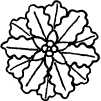| JOURNAL 1999 |
| North Craven Heritage Trust |
The agreement for this new one, signed 16th day of May one thousand seven hundred and sixty four, gives details of the original construction by Chas. Wilman for £8-10-0. It was observed that a circular wall enclosed the maximum amount of ground at lowest cost.
From here we went up the hill to reach Scaleberg Gill which is a delightful place at any time of year, but as the gate displays a 'Private' notice very few people explore this historic site. Although permission had been granted weeks before, we were stopped by a keeper. When he was convinced that we were a history group and not a shooting party we were allowed to pass. Notes by Mr T E Cooke, F S A, published in the Settle Household Almanac 1903 are of interest.
'Scaleber(g)'
About half a mile below Scaleber Force (near Settle), Scaleber Beck' takes an elliptical bend where the steep banks widen out a little; thus forming a haugh or flat space of ground. At the lower extremity of this haugh, a rocky hillock projects from the western bank, and presents a precipitous face towards the stream. The opposite bank, at this point, is also precipitous, so that the beck here runs through a narrow passage.
This hillock bears a strong resemblance in general contour to Castleber(g), Settle, though it consists of gritstone and is on a smaller scale. On its summit may be traced a large circular depression, which seems to be partly artificial, and to have been enclosed by boulders of rock, roughly placed between the large natural masses of rock which rise above the surface. This rude wall is most perfect on the southern side of the circular hollow, and two short undressed stones, standing erect, evidently mark an entrance, outside of which steps seem to have been formed in the steep slope of the hillock. Towards the west are the remains of an old wall formed of small boulders, with an angle on the south west. No mortar has been used in these constructions, and there are no markings on the rocks.
Adjoining this 'berg' on its NE side is a smaller one, presenting somewhat similar appearances on its summit, and, between the two the ancient road by which the beck is here approached at right angles from the north, dips down to the stream, where remains of an old timber bridge can be seen on the site of an ancient ford. This road, after crossing the beck, runs for a few yards along the level haugh in an eastward direction (i.e.. Upstream) and then ascends by an incline in the face of the green bank, till it loses itself on the open hillside - believed to be called Newton Moor from which Bookil Gill Beck flows into Scaleber Beck. On visiting this spot it at once occurred to me that we have here the 'berg (AS- 'BEORG', Scand - 'bjerg' - a hill used for defence) on which were huts (Scand: 'skali') and from which the stream derives its name. In the days of the Roman or Danish invasions, the spot in question would have afforded a good natural place of defence or temporary refuge to the tribes retreating from the Ribble Valley into the fastnesses of Attermire and Stockdale. I am not aware if any explorations have ever been conducted at this spot, or that its features have been studied from an antiquarian standpoint.
Perhaps at some later date we could return to this site when there is more daylight available. Many young trees have now been planted, which means that in a few years the shape of this hillock will no longer be seen.
We returned to Mitchell Lane, crossed over the Malham Road into Stockdale Lane, at the corner of which we went into the field for a few minutes to stand on the bank and ditch which marked the boundary of the Sawley Abbey property of Stockdale. From this we looked at the Scaleber pastures, some of the Settle common land which was divided under the 1758 Enclosure Act. In one of these enclosures the Settle 'town bull' was kept. (Barbara Middleton is so pleased that the Town Council no longer keep a bull.) The return was via the Attermire shooting range, which featured in the 1998 Journal.
Jim Nelson

J1999p20_25_files/tmpDBE-4.jpg
Ceiling boss Primrose House, Settle
Diana Kaneps